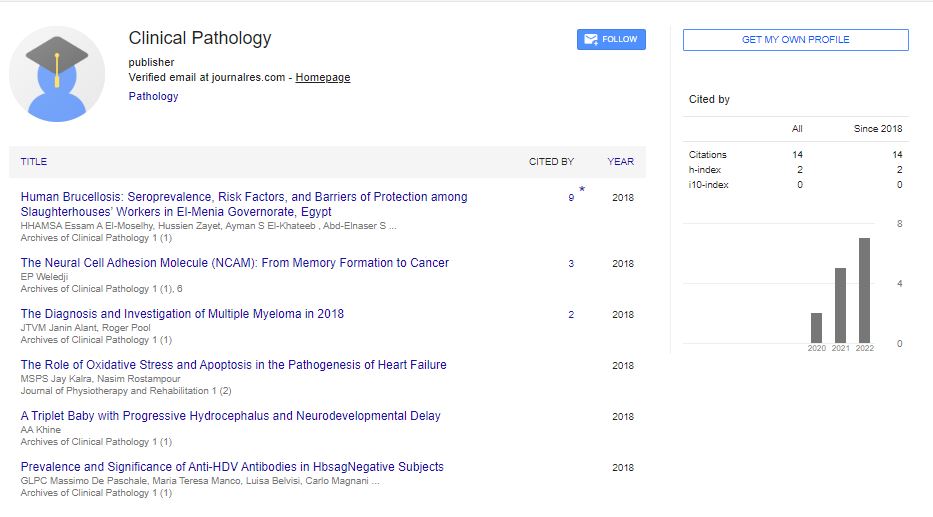Opinion Article, Arch Clin Pathol Vol: 8 Issue: 1
Anatomical Pathology: The Role of Disease Diagnosis
James Miller*
Department of Medicine, University of Padua, Padua, Italy
*Corresponding Author: James Miller
Department of Medicine, University of Padua, Padua, Italy
E-mail: jamesmiller@uiop.it
Received date: 20 February, 2023, Manuscript No. ACPY-23-93061;
Editor assigned date: 22 February, 2023, PreQC No. ACPY-23-93061 (PQ);
Reviewed date: 09 March, 2023, QC No ACPY-23-93061;
Revised date: 16 March, 2023, Manuscript No. ACPY-23-93061 (R);
Published date: 23 March, 2023, DOI: 2324-8955/acpy.05.03.100071
Citation: Miller J (2023) Anatomical Pathology: The Role of Disease Diagnosis. Arch Clin Pathol 6:1.
Description
Anatomical pathology is a branch of medicine that deals with the diagnosis of diseases by examining tissues and organs. It involves the study of the structure and function of cells, tissues, and organs in order to identify and diagnose diseases. Anatomical pathology involves the study of human tissues to diagnose diseases. It is a essiential component of modern medicine, playing an essential role in the diagnosis and treatment of diseases. Anatomical pathologists use various techniques and methods to study tissues and organs to understand the disease process. These techniques include gross examination, histology, immunohistochemistry, and molecular pathology. Anatomical pathology involves the study of human tissues obtained from biopsy, surgery, or autopsy. Gross examination is the first step in the analysis of tissue samples. It involves examining the tissue with the naked eye to identify any macroscopic abnormalities, such as the presence of tumors or inflammation. Histology is the microscopic examination of tissue samples, and it involves the use of stains and dyes to visualize the structure and function of cells and tissues. Immunohistochemistry involves the use of antibodies to identify specific proteins or molecules in tissues. It is used to diagnose specific diseases, such as cancer, by detecting the presence of specific markers on the surface of cells. Molecular pathology involves the analysis of DNA, RNA, and proteins to identify genetic mutations that can cause diseases. Anatomical pathology plays an important role in diagnosing diseases. The first step in the process is obtaining a tissue sample from the affected area of the patient. The sample can be obtained through a biopsy, surgical excision, or autopsy. The tissue sample is then examined under a microscope to identify any abnormal cells or tissues. One of the most important roles of anatomical pathology is the diagnosis of cancer. Cancer is a disease that occurs when abnormal cells grow and divide uncontrollably. Anatomical pathology is used to identify cancer cells and determine the type and stage of the cancer. This information is used to develop an appropriate treatment plan for the patient. In addition to cancer, anatomical pathology is used to diagnose a wide range of diseases, including infections, autoimmune disorders, and genetic disorders and monitor diseases such as HIV, hepatitis, and tuberculosis. It is also used to monitor the effectiveness of treatment. For example, if a patient is undergoing chemotherapy for cancer, the efficacy of the treatment can be monitored by examining tissue samples over time. This information is used to adjust the treatment plan to ensure the best outcome for the patient. Accurate diagnosis is essential in determining the appropriate treatment and management of diseases. Anatomical pathology helps in identifying the type and extent of cancer, staging tumors, and determining the prognosis of patients. It also helps in the diagnosis of infectious diseases by identifying the pathogens responsible for the disease. Accurate diagnosis is essiential in identifying genetic mutations that can cause diseases and in providing appropriate genetic counselling.
Conclusion
Anatomical pathology plays a critical role in diagnosing diseases and developing treatment plans for patients. It is an essential component of modern medicine, and it plays a major role in the diagnosis and treatment of diseases. The accurate diagnosis of diseases is essential for providing appropriate treatment and management. The field of anatomical pathology is constantly evolving, with new technologies and techniques being developed to improve diagnosis and treatment outcomes.
 Spanish
Spanish  Chinese
Chinese  Russian
Russian  German
German  French
French  Japanese
Japanese  Portuguese
Portuguese  Hindi
Hindi 